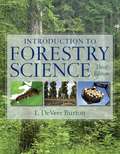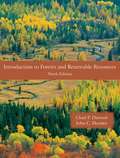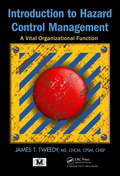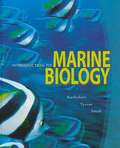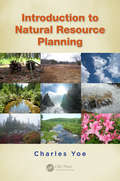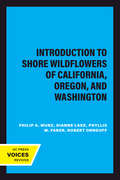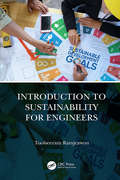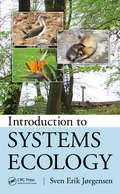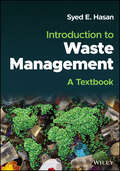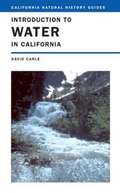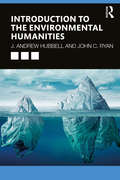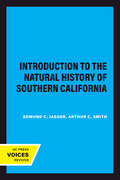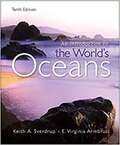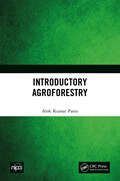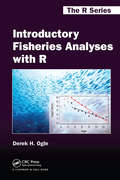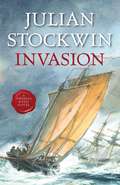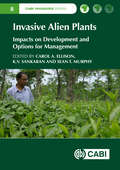- Table View
- List View
Introduction to Forestry Science
by L. Devere BurtonPractical, easy to understand, and up-to-date, INTRODUCTION TO FORESTRY SCIENCE, Third Edition provides readers with a comprehensive overview of the principles and practices of forest management that are commonly practiced in the United States. Appropriate for anyone interested in forestry or natural resources, this book is filled with visual aids and tools as well as career profiles which give readers an overview of what it might be like to work in the forest industry and demonstrate how concepts are applied in the real world. In addition to covering the basics of the biological processes necessary for the creation of forests, topics such as the economic impact of forests on the U. S. economy, government historical events and policies, regional differences in forests and forest management, and laws and regulations that govern the use of forests are presented.
Introduction to Forests and Renewable Resources
by John C. Hendee Chad P. DawsonThe introductory course in natural resources is broader and more diverse than ever. Today's students need to know how to manage forest, wildlife, watershed, and range resources in a variety of environments and serving the needs of myriad stakeholders. To that end, Chad Dawson has built on the foundation established by him and the late John Hendee to bring Introduction to Forests and Renewable Resources thoroughly up to date. The Ninth Edition has been reorganized to better address content-for example, policy and the differences between managing federal, state, and private land--that applies to all resources. While forests continue to be emphasized, more coverage is provided to other resources and to achieving management goals for multiple resources when considering topics like fire and recreation.
Introduction to Geographical Hydrology: Spatial Aspects of the Interactions Between Water Occurrence and Human Activity (Collected Works of Richard J. Chorley #Vol. 408)
by Richard J. ChorleyOriginally published in this form in 1971, the content of this book was originally part of a larger composite volume ‘Water, Earth and Man’ (1969) which provided a synthesis of hydrology, geomorphology and socio-economic geography. This volume brings together the systematic theme of spatial aspects of the interactions between water occurrence and human activity.
Introduction to Global Social Problems: Understanding Inequalities of Power and Social Justice
by Isaac Zvi ChristiansenIntroduction to Global Social Problems introduces undergraduate students to national and international social problems from a critical sociological perspective. Isaac Zvi Christiansen presents clear descriptions of each social problem, explains key concepts, and provides students with the relevant theoretical tools needed to grasp the interconnected nature of these phenomena.This volume covers significant and interconnected issues. The book begins with an explanation of how corporate interests distort the depiction of social problems. Chapters 2 and 3 provide empirical explorations of poverty and inequality on national and global scales, together with clear and accessible expositions of relevant sociological theories. Chapter 4 examines health and educational inequalities exacerbated by the economic inequalities discussed in Chapters 2 and 3. Chapter 5 introduces students to issues of racial inequalities in the United States and abroad, while Chapter 6 takes a comparative approach to examining crime and criminal justice. Chapter 7 examines modern-day imperialism and war, with special attention given to the military industrial complex, and a brief review of US interventions around the world in the twentieth and twenty-first centuries. Chapter 8 examines politics and human rights, including a critical, historical, and sociological analysis of Israeli settler-colonialism and successive US/Israeli assaults on Gaza. The book closes with an examination of population and the environment, with special attention given to climate change, and the pressing contradictions between capitalism and the environment.This textbook will be a vital resource for introductory students across the social sciences, especially in sociology, political science, and global studies. It provides critical wraparound coverage of the momentous, embedded social problems that interconnect across social, national, and regional boundaries.
Introduction to Hazard Control Management: A Vital Organizational Function
by James T. TweedyThe International Board for the Certification of Safety Managers (IBFCSM) has designated this text as the Primary Study Reference for those preparing to sit for the Certified Hazard Control Manager (CHCM) and the Certified Hazard Control Manager-Security (CHCM-SEC) Examinations. Introduction to Hazard Control Management: A Vital Organizational Func
Introduction to Marine Biology, 3rd edition
by George Karleskint James W. Small Richard TurnerImmerse yourself in INTRODUCTION TO MARINE BIOLOGY and quickly learn the content of the course. While taking an ecological approach, this biology text provides succinct coverage of the content while the photos and art work clearly illustrates key concepts. Studying is made easy with phonetic pronunciations, a running glossary of key terms, end-of-chapter questions, and websites provided at the end of the chapter, and lists of related articles found throughout the text.
Introduction to Modern Climate Change
by Andrew E. DesslerThis textbook is tightly focused on the problem of anthropogenic climate change. It is unique among textbooks on climate change in that it combines an introduction of the science with an introduction to the non-science issues such as the economic and policy options. Unlike more purely descriptive textbooks, it contains the quantitative depth that is necessary for an adequate understanding of the science of climate change. The goal of the book is for a student to leave the class ready to engage in the public policy debate on this issue. This is an invaluable textbook for any introductory survey course on the science and policy of climate change, for both non-science majors and introductory science students.
Introduction to Natural Resource Planning
by Charles YoeThis is an exciting time for natural resources planning. There are amazing technologies available to planners and a wide and growing array of resources, problems, and opportunities that need attention. Private and public interests are taking up these issues all over the world and at all levels of involvement. At the same time, inefficient planning
Introduction to Shore Wildflowers of California, Oregon, and Washington: Revised Edition (California Natural History Guides #67)
by Philip A. MunzThe diverse coastal habitats of the spectacular Pacific Coast include sandy beaches and dunes, salt- and freshwater marshes, coastal prairies and bluffs, riparian woodlands, and coniferous forests. This guide, first published nearly forty years ago, has introduced thousands to the wildflowers and other plants that grow along the coastline. Now thoroughly updated and revised, it is the perfect field guide to pack for a day at the seashore anywhere in California or the Pacific Northwest. * 268 species are described and illustrated by a new color photograph, a precise line drawing, or both * Includes native and introduced species of wildflowers, common trees, and shrubs * This new edition includes more plants, gives helpful hints for identifying species, and incorporates new taxonomic and distribution information
Introduction to Sustainability for Engineers
by Toolseeram RamjeawonIntroduction to Sustainability for Engineers aims to incorporate sustainability into curricula for undergraduate engineering students. The book starts with an introduction to the concept of sustainability, outlining core principles for sustainable development to guide engineering practice and decision making, including key tools aimed at enabling, measuring and communicating sustainability. It also describes concepts as life cycle assessment, environmental economics, related institutional architecture and policy framework, business context of sustainability, and sustainable buildings and infrastructure. Appendices at the end of the book presents a summary of key concepts, strategies and tools introduced in the main text. Five Key Benefits: A comprehensive textbook for engineering students to develop competency in sustainability. Presents a framework for engineers to put sustainability into practice. Presents the link between sustainability and the design process. It shows the application of a sustainable engineering design process for putting sustainability into practice. There are well woven case studies and links to websites for learning in various engineering disciplines. Includes challenging exercises at the end of each chapter that will inspire students and stimulate discussion in the class.
Introduction to Systems Ecology (Applied Ecology and Environmental Management)
by Sven JorgensenPossibly the first textbook to present a practically applicable ecosystems theory, Introduction to Systems Ecology helps readers understand how ecosystems work and how they react to disturbances. It demonstrates-with many examples and illustrations-how to apply the theory to explain observations and to make quantitative calculations and predictions
Introduction to Waste Management: A Textbook
by Syed E. HasanIntroduction to Waste Management An introductory textbook offering comprehensive coverage of the management of municipal, hazardous, medical, electronic, and nuclear waste Written by an experienced instructor in the field of solid waste management, this modern text systematically covers the five key types of solid wastes: municipal, hazardous/industrial, medical/biological, electronic, and nuclear, discussing their sources, handling, and disposal along with the relevant laws that govern their management. With its emphasis on industry standards and environmental regulations, it bridges the gap between theoretical models and real-life challenges in waste disposal and minimization. Instructors and students in environmental science, geology, and geography may use Introduction to Waste Management: A Textbook to better understand the five main types of solid waste and their management both from a local and a global perspective.
Introduction to Water Resources and Environmental Issues
by Karrie Lynn Pennington Thomas V. CechHow much water does the world need to support growing human populations? What factors influence water quality, droughts, floods, and waterborne diseases? What are the potential effects of climate change on the world's water resources? These questions and more are discussed in this thorough introduction to the complex world of water resources. The strength of the book is its coverage of the fundamentals of the science of water, aquatic ecology, geomorphology and hydrology, supplemented by internet resources and examples from water resource issues in the news to engage the student. The book begins with a short history of human use and influence on water, followed by chapters on the geomorphology, hydrology, chemistry, and biology of lakes, rivers, and wetlands. Major disease issues, worldwide water quality and quantity problems, and potential solutions are addressed. Water laws, water allocation, and the conflicts involved are discussed using US and international examples. Students in departments of environmental studies, life science, Earth science, and engineering will benefit from this broad survey of these crucial issues.
Introduction to Water in California
by David CarleThis book is a natural history guide, but one that recognizes the overwhelming role of humanity in the story of California water. The focus here is on a contemporary understanding of the natural waterscape and watersheds of the state and of the extended watersheds that people created by redirecting water across the West. The goal is to help Californians better appreciate the water that emerges from their taps, what it takes to move it there, and what changes occur in environments along the way.
Introduction to the Environmental Humanities
by John C. Ryan J. Andrew HubbellIn an era of climate change, deforestation, melting ice caps, poisoned environments, and species loss, many people are turning to the power of the arts and humanities for sustainable solutions to global ecological problems. Introduction to the Environmental Humanities offers a practical and accessible guide to this dynamic and interdisciplinary field. This book provides an overview of the Environmental Humanities’ evolution from the activist movements of the early and mid-twentieth century to more recent debates over climate change, sustainability, energy policy, and habitat degradation in the Anthropocene era. The text introduces readers to seminal writings, artworks, campaigns, and movements while demystifying important terms such as the Anthropocene, environmental justice, nature, ecosystem, ecology, posthuman, and non-human. Emerging theoretical areas such as critical animal and plant studies, gender and queer studies, Indigenous studies, and energy studies are also presented. Organized by discipline, the book explores the role that the arts and humanities play in the future of the planet. Including case studies, discussion questions, annotated bibliographies, and links to online resources, this book offers a comprehensive and engaging overview of the Environmental Humanities for introductory readers. For more advanced readers, it serves as a foundation for future study, projects, or professional development.
Introduction to the Natural History of Southern California (California Natural History Guides #13)
by Edmund C. Jaeger Arthur C. SmithThis title is part of UC Press's Voices Revived program, which commemorates University of California Press’s mission to seek out and cultivate the brightest minds and give them voice, reach, and impact. Drawing on a backlist dating to 1893, Voices Revived makes high-quality, peer-reviewed scholarship accessible once again using print-on-demand technology. This title was originally published in 1966.This title is part of UC Press's Voices Revived program, which commemorates University of California Press’s mission to seek out and cultivate the brightest minds and give them voice, reach, and impact. Drawing on a backlist dating to 1893, Voices Revived</DIV
Introduction to the Physical and Biological Oceanography of Shelf Seas
by John H. Simpson Jonathan SharplesIn this exciting and innovative textbook, two leading oceanographers bring together the fundamental physics and biology of the coastal ocean in a quantitative but accessible way for undergraduate and graduate students. Shelf sea processes are comprehensively explained from first principles using an integrated approach to oceanography that helps build a clear understanding of how shelf sea physics underpins key biological processes in these environmentally sensitive regions. Using many observational and model examples, worked problems and software tools, the authors explain the range of physical controls on primary biological production and shelf sea ecosystems. Boxes throughout the book present extra detail for each topic and non-mathematical summary points are provided for physics sections, allowing students to develop an intuitive understanding. The book is fully supported by extensive online materials, including worked solutions to end-of-chapter exercises, additional homework/exam problems with solutions and simple MATLAB and FORTRAN models for running simulations.
Introduction to the World's Oceans
by Keith A. Sverdrup Virginia ArmbrustAn Introduction to the World's Oceans, Tenth Edition, is an introductory oceanography text intended for students without a background in mathematics, chemistry, physics, geology, or biology. It emphasizes the role of basic scientific principles in helping understand the processes that govern the ocean and the earth. <p><p> To keep the text as current as possible, the authors conduct their own research and examine other findings such as analyzing satellite data and large-scale oceanographic programs. From this vast amount of data, they select interesting, relevant, and understandable examples that illustrate contemporary principles of oceanography. <p><p> An Introduction to the World's Oceans places greater emphasis on the physical and geological aspects of the oceans than on the chemical and geochemical properties, because the latter disciplines require more specific background knowledge. An ecological approach helps integrate the biological chapters with other subjects. Students are encouraged to look at oceanography as a cohesive and united discipline rather than a collection of subjects gathered under a marine umbrella. <p><p> As with all previous editions, the authors continue to make each chapter stand as independently as possible, so that professors can assign chapters in the order that best suits their classrooms.
Introductory Agroforestry
by Alok Kumar PatraThe origin of agroforestry practices—growing trees and shrubs with food and fruit crops and grasses is traditional and very old—but the science of agroforestry is new. Years of experience and experiments have shown that agroforestry as a land-use system is capable of yielding both food and wood and at the same time helps in conserving and rehabilitating the ecosystems. It has the capability to increase the overall productivity of land, maintain the nutrient balance in the soil, and above all, protect the nature. In the recent years, agroforestry has been recommended as a core subject in the curriculum of B. Sc. (Forestry) and B. Sc. (Agriculture) courses of agricultural universities. This book has been divided into ten chapters covering very comprehensive information on all aspects of agroforestry including history, concepts, systems classification, tree-crop interactions, planning and management, diagnosis and design, policy and projects, and propagation and management practices of multipurpose trees. This book is co-published with NIPA. Taylor and Francis does not sell or distribute its print and electronic editions in India, Pakistan, Nepal, Bhutan, Bangladesh and Sri Lanka.
Introductory Fisheries Analyses with R (Chapman & Hall/CRC The R Series #32)
by Derek H. OgleA How-To Guide for Conducting Common Fisheries-Related Analyses in R Introductory Fisheries Analyses with R provides detailed instructions on performing basic fisheries stock assessment analyses in the R environment. Accessible to practicing fisheries scientists as well as advanced undergraduate and graduate students, the book demonstrates the flexibility and power of R, offers insight into the reproducibility of script-based analyses, and shows how the use of R leads to more efficient and productive work in fisheries science. The first three chapters present a minimal introduction to the R environment that builds a foundation for the fisheries-specific analyses in the remainder of the book. These chapters help you become familiar with R for basic fisheries analyses and graphics. Subsequent chapters focus on methods to analyze age comparisons, age-length keys, size structure, weight-length relationships, condition, abundance (from capture-recapture and depletion data), mortality rates, individual growth, and the stock-recruit relationship. The fundamental statistical methods of linear regression, analysis of variance (ANOVA), and nonlinear regression are demonstrated within the contexts of these common fisheries analyses. For each analysis, the author completely explains the R functions and provides sufficient background information so that you can confidently implement each method. Web Resource The author’s website at http://derekogle.com/IFAR/ includes the data files and R code for each chapter, enabling you to reproduce the results in the book as well as create your own scripts. The site also offers supplemental code for more advanced analyses and practice exercises for every chapter.
Invaders
by Rob HaleThis fifth grade reading series introduces readers to ecology, global environment and the costly mistakes importation of non-native species have on the global ecology. "Invaders" seeks to educate its young readers to think carefully about how even small actions may have devastating effects on global animal and plant habitats.
Invasion
by Julian StockwinIn the 10th volume in the popular high-seas nautical adventure series, rumors fly of Napoleon's planned invasion of England, and British naval commander Thomas Kydd is sent to liaise with American inventor Robert Fulton, who has created "infernal machines" that can wreak mass destruction from a distance. Fulton believes that his inventions, namely the submarine and torpedo, will win the day for the power that possesses them, and Kydd must help him develop the devices. Despite his own belief that standing man-to-man is the only honorable way to fight, Kydd agrees to take part in the crucial testing of these weapons of mass destruction, which just may decide the fate of England.
Invasion Biology and Ecological Theory
by Herbert H. T. Prins Iain J. Gordon Herbert H. T. Prins Iain J. GordonMany conservationists argue that invasive species form one of the most important threats to ecosystems the world over, often spreading quickly through their new environments and jeopardising the conservation of native species. As such, it is important that reliable predictions can be made regarding the effects of new species on particular habitats. This book provides a critical appraisal of ecosystem theory using case studies of biological invasions in Australasia. Each chapter is built around a set of 11 central hypotheses from community ecology, which were mainly developed in North American or European contexts. The authors examine the hypotheses in the light of evidence from their particular species, testing their power in explaining the success or failure of invasion and accepting or rejecting each hypothesis as appropriate. The conclusions have far-reaching consequences for the utility of community ecology, suggesting a rejection of its predictive powers and a positive reappraisal of natural history.
Invasion of the Plastic Bags (Fountas and Pinnell LLI Purple #Level R)
by Judith StamperThe plastic bag problem. Can you imagine a world without plastic bags? Here's the shocking truth: disposable plastic bags didn't even exist fifty years ago. In less than fifty years, these bags have become part of everyday life. They're given out at stores, taken home, and then thrown away. The problem is they don't go away. They have invaded every corner of Earth. Many people say that the best solution to the plastic bag problem is to ban the bags altogether.
Invasive Alien Plants
by Carol A. Ellison K. V. Sankaran Sean T. MurphyInvasive alien plants pose a major threat to agriculture, the natural environment and livelihoods worldwide and create challenges for development. This is especially the case for those who live and work in rural areas. This book, for the first time, brings together a wide range of invasive plant specialists from the Asia-Pacific region who share their experience in addressing the problem and delivering solutions. Mikania micrantha is used as a case study in the book as it exemplifies many of the issues that need to be addressed. This neotropical vine is a major weed across the tropical humid zones of the region, where it smothers agroforestry, home gardens, natural forests and plantation production systems. The book emphasizes the social and economic implications of plant invasion, and discusses direct impacts on livelihoods and biodiversity. It explains how various approaches to management including traditional ecological knowledge and classical biological control can be keys to the delivery of sustainable solutions, focusing on experiences in India, Nepal, Papua New Guinea and China. The use of policy frameworks in biological control and other management measures are also described. Key features: * Empircal work from a wide range of geographical areas * Examines the wide scale multi-sector impacts of individual invasive species * Considers the practicalities of policy development and implementation * Shows how management solutions to invasive species are achievable This book will be of value to management practitioners, researchers, students and officials in policy, quarantine, and agriculture departments who wish to understand the importance of alien plant invasions in their countries.
